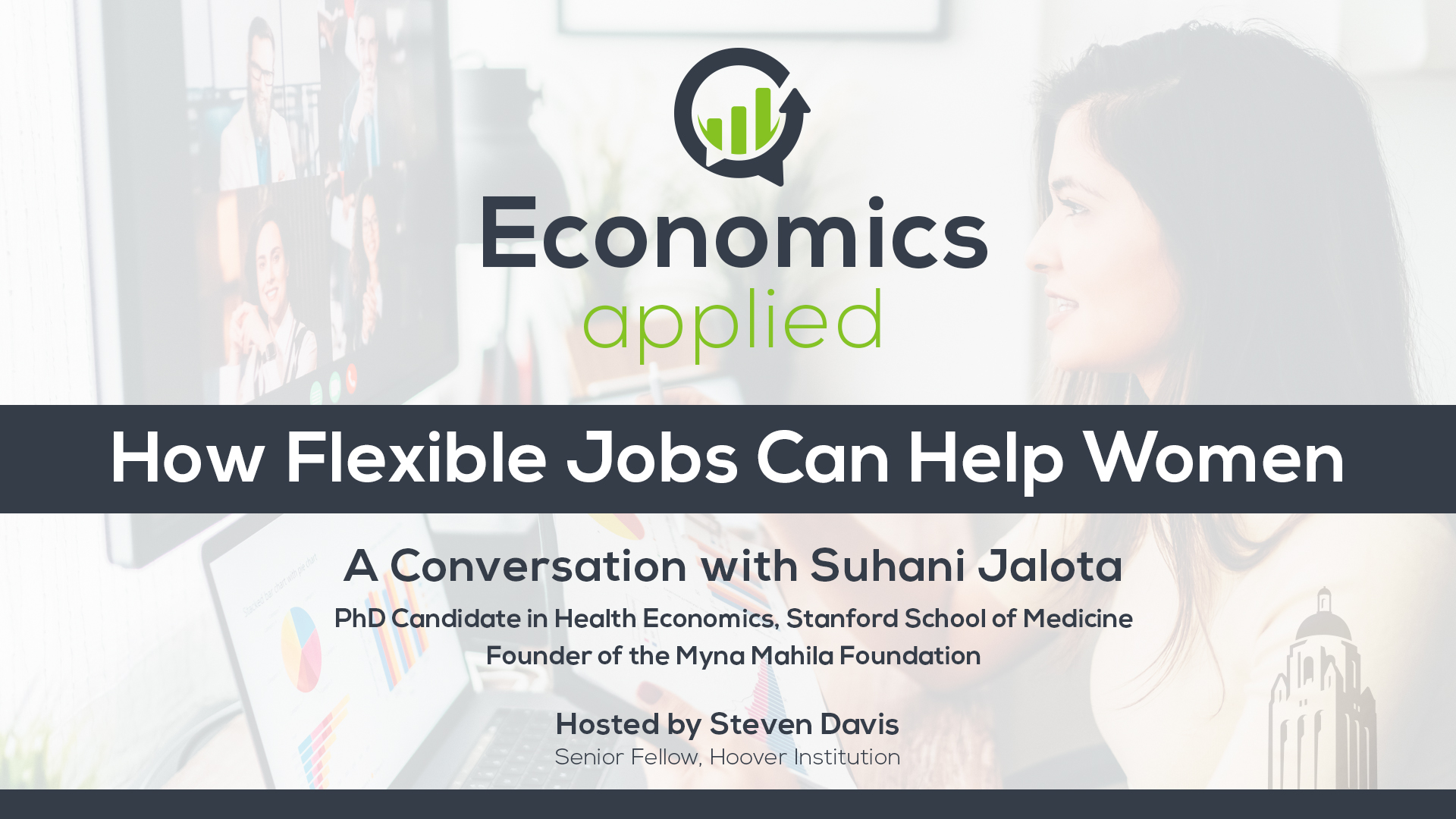Suhani Jalota joins Steve to discuss her study of how digital jobs can draw women into paid work in countries like India. The jobs, performed on smartphones, produce data that help train and evaluate AI models. Several job design features help overcome practical barriers to work and sidestep social norms that inhibit work for pay by married women. Jalota tells Steve how this idea can work in practice, how outcomes for women in these jobs can be evaluated, the broader effects of drawing women into this type of work, and what is next on her research agenda.
>> Steven Davis: Welcome to Economics Applied, a podcast sponsored by the Hoover Institution. My name is Steven Davis, I'm a senior fellow at the Hoover Institution and host of the show. Today, we are fortunate to have Suhani Jalota, a PhD candidate in health policy and economics at Stanford University. A recent graduate of Stanford Business School, and founder of the Myna Mahila Foundation.
Suhani, it's really great to have you here.
>> Suhani Jalota: Thank you so much for having me, Steve, it's really an honor.
>> Steven Davis: Likewise, we're privileged to have you. Before we dive into your research, could you just tell us a bit about the Myna Mahila Foundation, because it's related. And maybe also just tell us a bit more about yourself, let the audience know who you are.
>> Suhani Jalota: Yeah, thank you. So I started Myna Mahila about eight years ago now, and I've been working in urban slums in India for even longer. So I was 15 when I first met the women who really changed my life, and they're from the Mumbai slums. And I'd seen them suffering so much where they were living on railway tracks in these urban slum communities, domestically abused, for decades.
And I just couldn't understand why they were not up in arms and talking about these issues and considering them to be actually something wrong and something that needed to be changed. So I just couldn't understand why they couldn't see maybe, or others couldn't see that this was unjust, that there was something wrong.
So I started to just get a groups of women together of all different age groups just to talk about what matters to them, why are they not speaking up? And I think it was a lot of these conversations that really led me to realize that women didn't seem to have much agency in making their own decisions in this context.
And that that's how I decided, and along with a few other slum community leaders, to start Myna Mahila, to kind of change what was happening. And Myna is a bird that speaks a lot, Mahila means woman in Hindi. And our mission is to really help women speak up about the issues they're most afraid to discuss about.
So over the last few years, we've started three verticals in the organization. One is focused on women's health, second is on women's employment. And third is on women's research and trying to do research around these issues of health and employment to ultimately, with the mission to increase women's agency.
And in the last few years, our team has grown to about 75 people, reaching about one and a half million women at the doorstep all across urban slum communities in India. And over the years, while we focused a lot on women's health, and taboos, and stigma around their bodies, we've realized that the biggest contributor to agency, and our hypothesis is likely that it's earned income.
But we've not known over the last few years, really, how can we solve these problems for such women at scale? We're talking about more than 300 million women in India not being a part of the workforce who need work. And this is where the employee vertical really came in.
Is that how can we start thinking about scalable ways of providing employment to women in a way that was more dignified, that met their needs? And really, what are their needs in the first place? Do we even understand them? Do we understand women's determinants of labor supply very much?
And so that's over the last few years, our focus has really now turned a lot more, although we keep doing the health work also to this employment side. Given that a lot of the recent survey data in India has actually found that more than 75% of unemployed women don't even leave their homes once a day.
So it's these women that Myna Mahila Foundation is really targeting to build things from worker perspective first, from women.
>> Steven Davis: That's extremely useful background, and the audience will see it's highly relevant to the research we're gonna talk about and gives us a sense of where the research is coming from.
So that's also very impressive, and I wanna segue to the research now. And in particular, I wanna talk about a fascinating study that I heard you present at a conference on remote work that was held at Stanford in September. So I'll give a little bit of background context, if you get it wrong, you can, of course, correct me.
But the focus of the study, at least as I took away from your remarks at the conference was whether and how digital jobs that can be performed on a smartphone could help draw some of these women that you were describing into the workforce and work for pay. Sometimes outside the home, sometimes inside the home, but give them earned income and hopefully increase their agency along the way.
And since I suspect most of our audience is a North American one, I wanna just give some numbers that I find helpful for putting your study in context. So you mentioned in the study that fewer than a quarter of women in rural India are working for pay, and that's an extremely low number.
And by way of comparison, in the United States, it's more like 75%, working age women are actually working for pay in some way, shape, or form. In your context, and again, correct me if I'm wrong, these women are often either constrained, or at least heavily influenced by social norms that emphasize domesticity, staying at home, especially if they're kids, but maybe not even if they're kids.
There are societal pressures and pressures inside the family that kind of reinforce these norms and inhibit women from working for pay. So is that kind of a fair characterization of the setting in which your study takes place?
>> Suhani Jalota: Yeah, exactly, and I just wanna emphasize that even rural India also has really poor female labor force participation rates.
But ironically, even urban India, and urban India seems to have even lower. And in fact, labor force participation rates are lower for more educated women. So as education levels have started to increase, we've actually seen labor force participation rates decline with increased education. And we also see a huge drop between single women and when they get married.
So about 60% of single women in the age group of 25 to 29 are in labor force, and this number is about 20% for married women. This is not just after kids, but right after marriage.
>> Steven Davis: Right after marriage, okay. And so the distinction between marriage and kids is an important one here, because some women, I suspect, especially when they have the kids, they would like to stay home for a while and to focus on the kids.
And if they have enough income, then they can do that and still have a good life, but, of course, that's not the only factor in play here. So your study focuses on India, but the phenomenon you're describing is, of course, much broader than India, which is one of the reasons I think your study is quite important.
So first before you actually get into the research design, there's an idea that you had about how you might potentially draw these women into the labor force. Who potentially wanted to work, but were faced with these family pressures and social norms that were inhibiting their ability to work.
So what's the idea?
>> Suhani Jalota: Yeah, so I had seen, so over the last decade or so, we've seen digital gig work and micro tasking type of work actually grow. And although we've seen a lot more other types of groups that are non traditional are able to enter the labor force and have been working, we've seen a lot of this actually tends to be substitution.
And people are just moving from, shifting from one job to now a more flexible job location or more flexible jobs. And not really having new entries of new, new unexpected and really willing to work groups to enter. So in this context, we are looking at women that have had the opportunity, if they wanted, to go online and try to find work on Amazon mechanical Turk, for instance, or other companies like upwork.
But there are many barriers that make this kind of work very inaccessible to them. So what we basically try to do is can we take these tasks that are already accessible. And can be made accessible on women's own smartphones through these micro-tasks that we convert these larger tasks into smaller segments that women can complete and be paid for at piece rate, at a timing of their choice.
And in a very low-pressure type of an environment that is safe for them. So if it's at home, then can control our own safety. But even in locally controlled office setups, where it is very much in her own community, women only. And that was really important for this work.
And that also allows childcare facilities and burden to be also shared and taken care of by other women also working on the platform, creating this community upliftment while providing jobs to women through these digital platforms. And we've seen that as the need for AI models need to be more diverse and need to mitigate a lot of gender bias.
This algorithmic gender bias and ethical AI considerations are hoping and wanting to get more such non-traditional people into the workforce, into actually labeling such sorts of data. But are not able to attract this population precisely because it's still not accessible to them so taking.
>> Steven Davis: Just get a lot of ground.
I wanna reiterate in somewhat different language, a few things you said, make sure I've got it right. First, starting with the last point you made. The point about the AI is for people who aren't fully informed about how AI often works. It's often trained by humans and then the training, the classification that the humans does then use to build large scale models that can be applied more broadly.
Okay, so that's the kind of input that these women are creating, correct?
>> Suhani Jalota: Right, exactly, so it's creating the training data sets for the AI models and verifying the output from the AI models as well.
>> Steven Davis: Okay, yes, of course. Okay, so that means these women have to be literate if they're basically reading things and okay, so that's just an important point.
But then the description of the job you gave, there's several aspects. These jobs are flexible, you described in several ways, and I think it's worth highlighting that. They are flexible as to where they're done, either in these local centers where women feel safe or at home. They're flexible as to when you do the work.
So there's flexibility in that dimension. They're also flexible whether you're doing them at home or in these local facilities, and that they can be done at the same time as you're looking after kids.
>> Suhani Jalota: Yep.
>> Steven Davis: Okay, and they're also flexible in a fourth sense, which is they can be done in small little chunks.
>> Suhani Jalota: Right.
>> Steven Davis: Okay, and I imagine a woman can do one hour a day or four hours a day or something like that on this platform. So I just wanted to emphasize that this is flexibility along several different attributes of the job. And that all those various forms of flexibility probably are important to different degrees for different women and helping potentially draw them into the workforce.
Is that the right way to think about it?
>> Suhani Jalota: Yes, absolutely and so we've tried to minimize as much as we can what we would consider the practical barriers to work. So things like fixed schedules or fixed payments or not having childcare facilities, having to travel a long distance to go to work.
So we've tried to reduce a lot of those barriers and provide a job almost as if it is at home, except that it's right outside home.
>> Steven Davis: Right.
>> Suhani Jalota: They should be able to have similar flexibility.
>> Steven Davis: So that's the idea. Okay, and the idea is plausible. But what's very nice about your work is you take, you got this on the ground apparatus of the foundation and the partners you work with, you've got a sensible idea.
But then, rather than, just as we would typically do things, at least in the US government, just say, hey, this sounds good, let's spend a bunch of money and throw it at it. You're gonna say, well, let's evaluate this systematically to assess whether it works as we expected, how big the effects are, where they show up or they don't show up.
That's the research part of this. And that's where you really need a lot of careful thought about the experimental design, the research design, whichever we want to call it, and also the data collection and evaluation part. So take us we have the basic idea now. Describe the research design so that we can actually learn something.
We're not only helping these women, we want to learn how to what works and what doesn't work so we can potentially scale this up. So tell us about the research design.
>> Suhani Jalota: Yeah, so we run two randomized control trials with about 3200 married households in the Mumbai slum communities.
And we've randomly assigned these women, these married women, into either working from home or working from these local offices. And we specially designed these offices, about 35 of these. And women were assigned to one of them that was close to them in their own community. And these offices were newly set up for the purposes of doing this work.
Where women were working on their smartphones, the jobs were identical both from home and from these local offices. In addition to that, we also cross randomized women into one of three different wage levels. So a low wage was about a $60 a month that women can earn up to.
So this is if they work about two hours a day for six days a week, they could earn up to $60 a month. Second wage level, a medium wage, was about $150 a month, and the third was about $300 a month. And this is actually higher than what the husband even could be paid for the household income.
So these are pretty even the $60, even the low wage was pretty significant.
>> Steven Davis: How did you get selected into the candidate of women who would be presented with this opportunity?
>> Suhani Jalota: Yeah, so-
>> Steven Davis: That's an important part of the design.
>> Suhani Jalota: Exactly, yeah, so we were essentially working in slum resettlement communities.
These are all government buildings where people had been moved into from slums. So we had a listing from the government where we randomly selected a few different areas in the city that were close to each other. And then from that list, we listed every single household basically, this is more than 20, 30,000 households.
And then we identified women with our eligibility criteria, which required that women were between the ages of 18 to 45. They were married, they had access to a smartphone. Because we were not providing the smartphone, they needed to have access to this already. And we also did a mini-screening test where women were given these types of sample tasks to do, and we were able to observe whether or not.
They're doing them correctly. And then the women also, have you only selected a single woman from a household, so even if there are multiple women. And they needed to be unemployed, which was, anyway, majority of the women. But we had unemployed married women who were smartphone users, essentially, as part of our sample.
So we had about a 20% eligibility match. And then we then started doing. We randomly assigned these women into the different treatment arms, all with equal probability. So we had six treatment arms overall, given that we had two locations, home and office, and then the three different wage levels, the low, medium, and high.
We also had a control group.
>> Steven Davis: Make sure I understand. So you selected these neighborhoods in Mumbai, explained how that works. You then identified women who were eligible by your criteria, these are preset criteria. About 20% of the households had a woman who was eligible. Am I correct?
>> Suhani Jalota: Yes.
>> Steven Davis: And then you approach these women. What fraction of the women you approached took up? And there's the treatment arm where they can work from home, and there's a treatment arm where they go to the local facility. So what was the take-up rate to this offer, so to speak?
>> Suhani Jalota: Yeah, so from home, we see that the take-up rate was about 56%, which is significant, given that these are all women that are unemployed and they were not working at all. So 56% of them actually start to work on the platform. And from these local facilities, which are so similar, we've tried to minimize a lot of the practical barriers to work, we see that the take-up is 27%.
So that.
>> Steven Davis: Okay, also high, but a lot lower, okay. And how long did the experiment run?
>> Suhani Jalota: The experiment was for two to three months, the job intervention that the women.
>> Steven Davis: And then, as I understand it, you did other things. This I know from listening to you talk previously, both facilitate participation, dealing with potential, I don't know how to say it, conflicts within the household.
This is something you could do and perhaps not tell your husband about. So explain that to us how you set that up.
>> Suhani Jalota: Yeah, so in this context, while women were deciding the work, we had about 90% of women had discussed the job with their husbands before making their final decision, according to the women themselves.
But although they were sharing this information with their husbands, they were maybe not sharing the wage-related information as to exactly how much they were earning. And we had about 40% of husbands who stated that they had no idea how much their wives were actually getting paid, even as they were working on this platform.
So women were hiding information. But we had randomly assigned about 50% of the households to also receive a husband information treatment, where the husbands were also surveyed and provided with this job-detailed information to see, does this affect the take-up at all in the family? And also, husbands refused their surveys as well as a revealed preference for whether or not they actually are accepting of their wife to work.
And we found about 30% of husbands outright refused their survey by stating that, I don't wanna talk about my wife's work. She can't work anyway. Essentially not allowing her.
>> Steven Davis: But if the husband said that in response to your survey, you still offered the woman the opportunity to participate, is that right?
>> Suhani Jalota: She was offered the opportunity to participate before we spoke to the husband anyway.
>> Steven Davis: Before, okay.
>> Suhani Jalota: Before. And if the wife also stated, like many wives requested that we do not speak to their husbands, so we did not speak to their husbands in those as well.
But we also tried to make sure that in this context, we're not creating any additional conflict at all. But we were definitely, I think, igniting new conversations in families. We do find that at Enline, women for the first time had even discussed working in a job along with their husband, which they had never done.
>> Steven Davis: You may be creating some conflict, but that strikes me as okay. I mean, it seems given your enterprise, you're gonna bump up against some preconceived notions and social norms, and people are gonna have different views about those.
>> Suhani Jalota: Yeah, and I think one norm that really came out strongly, which is pretty prevalent in Middle East and South Asia as regions in general, is this norm, where essentially, it means curtain.
Where even without these practical barriers, a married woman should be behind the curtain and should be secluded, essentially, from outside. And that makes the home-based job, so not just flexible, remote work, but really from home so important.
>> Steven Davis: Yeah, so I wanna drill a little bit on that.
There's, at least to my mind, and you can tell me if you disagree, three different related norms that could be in play. You just described one, which is women should stay in the home and not be seen by outsiders. A second is women are responsible for raising the kids and that's what they should focus on.
Those may overlap, but they're not the same. A third is, the woman shouldn't have any control over income in the household except subject to the husband's oversight. Those are different norms. Do you have a sense, maybe you can't unpack those, maybe they're all in play and you're not really in a position to speak about the relative importance.
But I'm just curious, which of those three norms is really the key thing in your context?
>> Suhani Jalota: So we think it's the first, and here's why. So for each of them, the first one is just about seclusion. So we can get at that by understanding whether or not a woman is able to work in a very short time frame job from home and from right outside.
The second, on the childcare, childcare seems to matter more if it's a longer duration job. This job, women could work even just for half an hour a day. And from our time use surveys, we found that women were spending maybe six hours a day on housework and childcare.
And that they in fact did have additional time when the children were sleeping or under the supervision of other people in the family as well who were available. And yet, if those women were not working, and we also did not find a difference between women that had young children and did not have young children in take-up of office-based jobs.
>> Steven Davis: I see.
>> Suhani Jalota: Really didn't seem to be that constraining in this setup. And on the third, about income in general, the women that are not allowed to work even from home are likely the ones who would fall in that category. So the 40% or so who have not taken up the work even from home are part of this category of women that are likely to not be allowed to work, period.
They would not matter. But the location difference is not likely explained by income.
>> Steven Davis: Okay, so we started to get into the results. But let me just ask you now, why don't you lay out, set out for us your main findings as you see it, and then we'll go from there and discuss those.
>> Suhani Jalota: Yeah, so the first is that the take-up of these jobs is pretty high overall. So we find that there's this huge latent labor supply that we can tap into. So a large number of housewives can actually do this work. Second is that there's a much higher take-up, more than double the take-up from home.
And this is persistent throughout the entire duration of the job. So the difference between home and office take-up continues to be about the same even up until the end. And we do find that office-based jobs do have other benefits as well around social networks gains and just women are feeling like they have a change in identity.
As well, so there are other benefits of working from office. The third is, that we find that wages don't really seem to affect take up of this job at all from home or from these office setups. So for women that are being paid between $60 to $300 a month, so that's about a five fold increase, we don't see a difference in entry at all.
>> Steven Davis: Yeah, because that's pretty striking. But now this is just to use economist speak, this is the extensive margin of response.
>> Suhani Jalota: We're talking about Margin response.
>> Steven Davis: But conditional on accepting this kind of job, how does the wage affect labor supply hours per week?
>> Suhani Jalota: Yeah, so we find that there is much lower retention in the low wage job, but the medium and the high wage are very similar.
There's no difference almost up until the completions in the intensive margin, both in terms of hours worked, productivity as well, between the medium and high wage is not very different at all. But with the low wage, we see lower productivity and lower completion rates and retention overall. So that's why we do see that some level of wage probably matters, but the medium wage seems to be what is, it's leveling off and plateauing off.
>> Steven Davis: Just put this into perspective, this medium wage, as you call it, how large is that, say, as a percentage of what the average husband of these women earns?
>> Suhani Jalota: Yeah, it's about 50% of the household income.
>> Steven Davis: Okay, and you didn't mention this today, but again, I recall this from your presentation at the conference.
Women have, you encourage, is that right? Women to set up their own bank accounts to receive the payments?
>> Suhani Jalota: Right, so that was only after they had accepted the job, only after they did not have an account, then we open bank accounts for them as well. So that was under their own name.
>> Steven Davis: And what fraction of women are actually having the checks, got their own account rather than their husband's account or a joint account?
>> Suhani Jalota: So about 70% of the women had it in their own accounts, and then the others were mostly joint.
>> Steven Davis: Okay, so, but this goes back to your remarks at the outset of our conversation about agency and increasing agency of women over time.
I gather the hope here, and maybe, and it's a plausible one, that for women who are able to participate in these kinds of work programs, it may lead to increases in their agency over time because they're basically controlling more of the income that flows into the household. Which obviously means they have direct control over some of the income, but also may change how their husband, their partner, or their in laws think about them as a human being.
Can you just comment on that? Is that, I know it's not really, we've stepped outside the scope of the study now because I'm talking about longer term effects. But do you have views on that based on either your personal observations or other research?
>> Suhani Jalota: So this is really in terms of how husbands are viewing the wife's income and how important that is.
>> Steven Davis: And whether it alters the decision making distribution within the household.
>> Suhani Jalota: Yeah, so it seemed that husbands were dismissive of women's incomes and the amount that they were earning and that seemed particularly true for the high wage arms. And that was a little surprising for us initially, because we found that those husbands, especially when we were doing the husband surveys, and we found that these husbands were essentially stating that we don't even touch this money.
We will not use this money, we have no idea how it's going to be spent because this is hers alone. But this also implies that this money is not going to be used for any of the essential household expenses, so rent and ration food.
>> Steven Davis: Okay, but this is from the survey you described earlier?
>> Suhani Jalota: Yeah.
>> Steven Davis: This survey, as I understood it, is undertaken pretty early on in the process. And I'm trying to get a sense of whether over time, I can imagine, for example, that a wife uses the money to help send one of the kids to a better school or get some tutoring on the side, and the husband may be initially dismissive.
But I'm being hopeful here over time, he says, look, there's value into what my wife has brought into the household in the way of income. And I think about her and respect her in a different way over time as a consequence of this. Some men may react that way, some may not, some may react negatively.
I'm just, I'm groping here about what are the longer term potential impacts for how the household functions from this kind of intervention.
>> Suhani Jalota: But you're absolutely right. So there are these different types of men, and I think we categorize them as three types in our study as well.
So we call it progressive households, less progressive households, and then conservative households. So, it's very likely that in the conservative households, the perception of a wife's income or if, especially if it's continued over time, might actually be negatively perceived. And might either cause her to drop out or might cause her to hide how much she's earning over time so that it doesn't create conflict in the family.
In the progressive households, that's likely to be the reversed, where there's potentially likely to be higher respect for a working woman and she's able to contribute to the family, and especially even the in laws might be respecting of the woman in that context. It's this middle group, the less progressive but not yet fully conservative group, that is a little bit unclear how they would react and we were trying to get at that difference.
So essentially, we categorize the households as if you're not allowed to work at all from home or from outside, then the woman is likely to come from a conservative household. If you're likely to be allowed to work from both locations, you're likely to be from a progressive household.
But if you're likely to work from home, but not from outside home for a similar job, then you're in this middle category. And we're interested in looking at, and I think it's not clear exactly what the long term effects for them could be and in which direction do they really go.
And this does probably divide by ethnicity and by type of women as well, so by different religions, you might expect to see different results, by caste we might expect to see different results, and by income level of the family, you might expect.
>> Steven Davis: Okay, so this is a pretty complex set of issues here and requires probably quite a bit more study to come to a firm conclusion on.
So I want to go back to the headline results that you described earlier, and you've made it clear, but I want to just reiterate it. The magnitude of the labor supply effects that you're finding, especially when there's an opportunity to work from home, but even when there's the opportunity to work in these local centers, it's enormous.
I want to underscore that, there were 56% of the women who, when presented with the opportunity to engage in these jobs on their smartphone at home, said, yes. But these were women who were not previously working, was about roughly half that, for the women who go to the nearby center.
Those are enormous labor supply effects, okay, and that, just want to put reiterate that. So, and you have a model here in which these women are doing, they're not just doing make work, they're doing something. They're providing a kind of labor service which is in demand and probably increasingly so, given that we're kind of in the incipient phase of a possible AI revolution, which is.
There's a huge need for this kind of training work and evaluation work. So bottom line is there seems to be a lot of scope to scale up the kind of intervention you undertook and ideally get profit oriented companies to say, look, here's a labor market we can tap to engage in an activity for which we have lots of demand.
And then this is probably a labor market that will accept lower wages than a comparably skilled market might in other places, other countries, or even men rather than women. So can you speak to that? That strikes me as a really exciting aspect of what you've done, the scaling up possibilities, but speak to that.
>> Suhani Jalota: Yeah, and there's so many companies out there right now that are, especially with AI LLM models and just the large language model era that's coming out now. Where to train this data, we need particularly invisible voices to be online now. And that makes it even more relevant to bring people's voices who haven't been online before, who are using smartphones for the first time, who are using Internet for the first time to actually start engaging and doing this type of work.
So to give you an example of what a task actually looks like, and it can be as simple as something like this, where a woman is reading out a text in her own local dialect and recording herself speaking that particular text. So this creates a speech to text and a text to speech database that is then useful for companies like OpenAI, Microsoft, like Amazon, like Google, to be able to help with say, things like translations, to be able to create new modules and datasets and information and content in a mix of languages.
There's a lot of content now out there in Hindi and English combined, in French and English combined, all of these different languages that haven't actually had much of an online presence in the past. So we need more such diverse workers, and we don't have enough women's voices out there.
So where this really creates bias for the data sets is where sentiment analysis or any aspect that is not as objective. Women and men tend to have different distributional responses to these kinds of questions. So this really does make a business case for a lot of companies to get onboarded, and we've seen that with ethical AI concerns and privacy concerns starting to become more of a topic of debate, especially in the valley.
I think we've not had a lot of local companies in India and other places, I think really rise to this occasion at the moment. So it's a lot more fragmented, but it does require a movement of many companies coming together and recognizing that it's possible to get these people who it was not possible earlier to get online now.
COVID has also helped with that as more people have smartphones now in every house, online learning, and now it's accessible by women. But we can really use this to get a lot more people to work and work accurately. It's not unproductive work, it's actually quite productive, it's quite accurate work that can be done very cheaply from non centralized offices.
>> Steven Davis: Right, okay, so what's next on your agenda? Just briefly, where are you going? What can we have you back on the show for 6, 12, 18 months down the road?
>> Suhani Jalota: Yeah, so three things. First is we are very interested in looking at longer term jobs. We had provided two to three month jobs as part of this experiment.
We ran another experiment in West Bengal with again, only a month long job. So we wanna see longer term jobs and look at their effects of the extensive margin take up, so for more permanent employment and also their productivity and retention over time. Second is around identity shifts.
So we found that while women from home, even if they continued to work from home, were still considered housewives. And women that worked from office right outside their home were considered working women. How does this identity shift actually create maybe resistance from households to move to the office setup?
Or does it create a higher willingness for women to work to be able to overpower that household constraint? We don't know, I think that's another area that we're trying to understand. And how does hybrid models actually also affect identity shifts? Third is on the overall use of such AI jobs for other use cases.
So this is kind of transitioning now from a labor supply problem to a labor demand problem. We've seen that there's huge labor supply for such types of work, but are there enough jobs and can we provide enough jobs for such skill set of people without having to upskill them dramatically or how much upskilling would really be required?
And so I've been interested in the overall use of LLMs and AI types of jobs now for specific domain use cases to upskill people.
>> Steven Davis: Now, those are all super exciting, those three ideas. And please keep me up to speed with what you're doing. I think your work's both fascinating from a research perspective, but also has potentially profoundly valuable social benefits.
So I applaud you for the work you're doing and keep it up.
>> Suhani Jalota: Thank you so much, Steve.
>> Steven Davis: Okay, thanks a lot for being here, take care.
ABOUT THE SPEAKERS
Suhani Jalota is a PhD candidate in Health Economics at the Stanford School of Medicine, and a Knight Hennessy Scholar. She holds a Bachelor of Science in Economics and Global Health from Duke University (2016). She is also the founder and director of a women's health organization, the Myna Mahila Foundation, based in Mumbai, India. She has been working in urban slum areas and rural communities researching and designing strategies on projects including the health of adolescent girls, as well as public policies concerning water, sanitation, and social protection. Her economics honors thesis topic looks at how slum redevelopment has negatively affected child health outcomes, even as rapid urbanization calls for policies that keep people healthy and safe. She wants to further explore national health systems, their design, as well as challenges and outcomes, especially from a developing country context.
Steven J. Davis is the Thomas W. and Susan B. Ford senior fellow at the Hoover Institution and senior fellow at the Stanford Institute for Economic Policy Research (SIEPR). He is an economic adviser to the U.S. Congressional Budget Office, elected fellow of the Society of Labor Economists, and consultant to the Federal Reserve Bank of Atlanta. He co-founded the Economic Policy Uncertainty project, the U.S. Survey of Working Arrangements and Attitudes, the Global Survey of Working Arrangements, the Survey of Business Uncertainty, and the Stock Market Jumps project. He co-organizes the Asian Monetary Policy Forum, held annually in Singapore. Before joining Hoover, Davis was on the faculty at the University of Chicago Booth School of Business, serving as both distinguished service professor and deputy dean of the faculty.


















